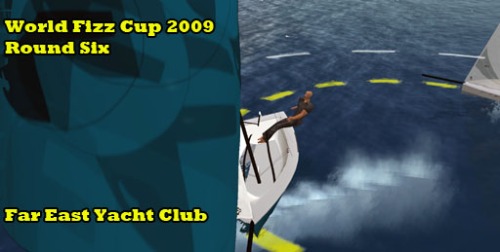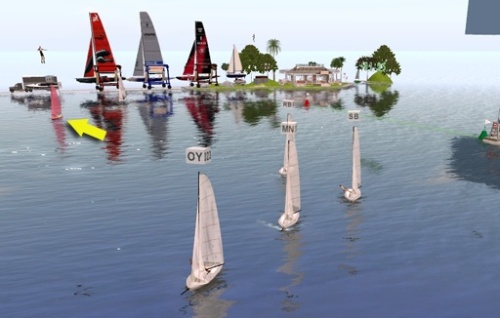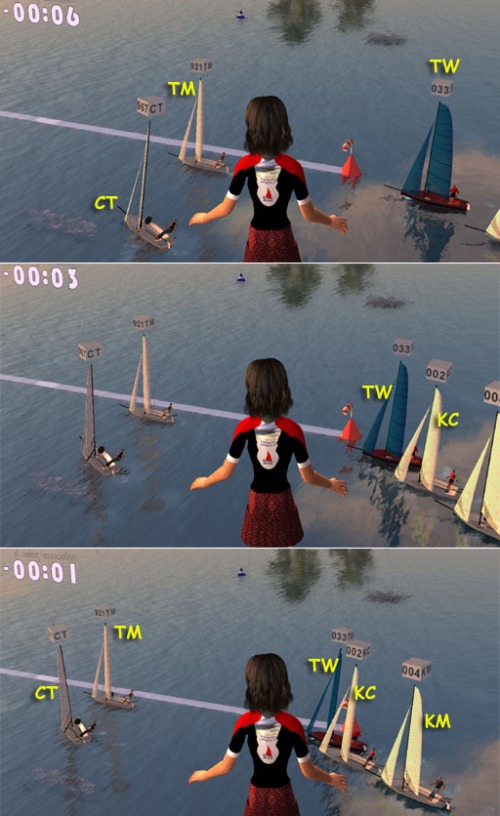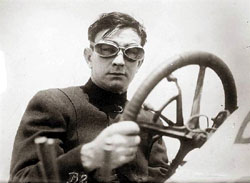
PHRF racing takes a different approach to make a sailboat race fair and evenly matched. PHRF acknowledges that skippers with different classes of boats often want to compete with each other in regattas. The sailors are drawn togetherby a common love of the sport, and the differences between their boats seem minor in comparison. Racing a mixed fleet presents problems however, since boats come in all shapes and sizes and are suited for different tasks and sailing conditions. In order to make this type of mixed-class racing fair, PHRF uses a handicapping system that adjusts a race boat’s finish time based on a number of performance factors, including the boat’s design, equipment and rigging. That way a skilled, attentive skipper of a slow boat can still beat a distracted, less intense skipper who’s eating a ham sandwich and chatting on a cell phone while at the wheel of faster sailboat.
From its very beginning in the winter of 2006/2007,
SL’s Big -Boat Races were modeled after RL PHRF. All comers were invited, and the practical definition of “Big Boat” was “
anything other than a Tako.” For some time that Spring there was considerable chatter in the Forum about ways to handicap different boats in the fleet, and there were even
discussions about handicapping the sailors in order to prevent a small group of prodigous skippers from winning so many races!
Luckily, that idea of punishing the winners didn’t get very far (grin), but, as the number of sailboats in second life multiplied, the need for PHRF also increased, and was self-evident.


In retrospect it probably sounds like a lot of work, but it was also a huge amount of fun… there are lots of discussions about the significance, if any, of the data and many sailors chimed in to add extra laps to answer specific questions that arose.
That pile of accumulated lap data was used to generate and then test a series of ‘handicap factors’ for the different boat classes. We actually ended up with a system that I think is more similar to Golf than sailing, but the same principles apply in both sports. To make the sailing handicap easy to use, we chose a popular “middle-of-the-lapspeed-road” boat: Trucordia Yawl; we defined it as the ‘index boat’ and arbitrarily gave it a handicap of 1.00 (like ‘par’ in golf). All other boats where then classified as slower or faster than the Yawl. By that measure, the venerable old Tako 3.3 came in with an extremely fast 1.35 handicap, meaning it was an average 35% faster than a Yawl. By that same measure, the little Trudeau Sojourner rated 0.70, a full 30% slower. the boat was slow, but it had good endurance and a lot of spunk (ask Liv Leigh who did many of the Sojourner laps both last year and this year).
With the November OS Sim crisis (remember that?) and the heterologous displacement grafting of USS sims to Mainland that followed, handicap hotaps officially shut down and the PHRF database went on sabbatical. I don’t know if the spreadsheet was tired, but I do know the few dozen skippers deserved a vacation from hotlapping.

But nothing in the digital ocean that spans SL ever stands still, and in those long winter nights while PHRF was away changes were afoot. In fact, on scores of seabeds, seminal ideas flowed into pliable prims and the genetic code that underlies the sacred lift engine recompiled once more, giving birth to the first frail attempts at new generation of sailcraft… The Rite of Spring this year was full of excitement as a host of new and experienced boatwrights launched remarkable additions to their yacht lines. It was time to resurrect PHRF again; There was a new and challenging series of boats to test.

Is the new fizz really slower than the old fizz? How much? is that even a relevant question? and what about the Trudeau quintuplets… Twenty, Knockabout, LCat, Tahiti II and J-Class? where do they fit in alongside the orderly numbers from last year’s PHRF fleet? A whole series of new boats were sailing across the waterways, with bewildering array of new features.  Some had keels and some had centerboards, still others had multiple headsails; some even had adjustable rigging and sail shape. More serious, some fundamentally changed the lift algorithm by including apparent wind to the calculations. Others objected to this obvious step, continuing to live in denial and insisting their wind was the “real,” “true” wind. My favorite among the sudden burst of sailing options and innovations was Trudeau’s addition of a sail-shortening effect to balance the boat under strong winds. The discussion reminded me of that classic movie, High School Confidential. I mean, Trudeau Yachts launched four new boats that that each beckoned innocent young sailettes to clamber aboard with the enticing line: ” Would you like a One-Reefer or Two?”
Some had keels and some had centerboards, still others had multiple headsails; some even had adjustable rigging and sail shape. More serious, some fundamentally changed the lift algorithm by including apparent wind to the calculations. Others objected to this obvious step, continuing to live in denial and insisting their wind was the “real,” “true” wind. My favorite among the sudden burst of sailing options and innovations was Trudeau’s addition of a sail-shortening effect to balance the boat under strong winds. The discussion reminded me of that classic movie, High School Confidential. I mean, Trudeau Yachts launched four new boats that that each beckoned innocent young sailettes to clamber aboard with the enticing line: ” Would you like a One-Reefer or Two?”
( In case you think I brought up the movie High School Confidential as as part of my usual tangential thought process here, well… you are probably right.. but there’s another reason too. If you look at the picture on the left, it’s pretty obvious that Phillip Linden’s Earth-Godess typical female avatar shape emerged from the distorted personal ideas of female anatomy resulting from his exposure to this film during a critical developmental stage.)
 Anyways… In March Cynthia Centaur, Fancois Jacques and I announced the 2009 version of PHRF Hotlaps using the web-based Race Line in Madaket. The Madaket line was a big hit, with nearly 500 recorded laps in the past ten weeks. The setup is easy, and largely foolproff for novice and expert sailors alike. It’s intended primarily for solo sailors, including PHRF hotlaps or skippers working on their sailing skills.
Anyways… In March Cynthia Centaur, Fancois Jacques and I announced the 2009 version of PHRF Hotlaps using the web-based Race Line in Madaket. The Madaket line was a big hit, with nearly 500 recorded laps in the past ten weeks. The setup is easy, and largely foolproff for novice and expert sailors alike. It’s intended primarily for solo sailors, including PHRF hotlaps or skippers working on their sailing skills.
Since the Madaket line opened, a full three dozen sailors have helped collect lap data and saved it to the database. please give an incredibly huge woot! to the following super sailors: 
Gemma Vuckovic, Francois Jacques, Carmen Foden, joro Aya, Garrick Diesel, Justbent Clarity, Heidi Stiglitz, Angus Moonwall, Dunan Wilder, Chaos Mandelbrot, Cory Copeland, LDeWell Hawker, Oliphant Ming, Julia Ceres, Liv Leigh, Triton Sands, Hal Burnstein, Blackbird Latte, Argus Farman, Vin Mariani, Rodman Mapholisto, Alain Gloster, Jane Fossett, nobuko Criss, Allie Tomsen, Angus Moonwall, Bunnie Mills, CS Price, Emme Eales, Jehan Jameson, Liv Leigh, Naeve Rossini, Nomad Zamani, Reven Fhang, Quirky Torok, and Masahisa Greenwood.
As of June 1, nearly 300 usable data points were logged using the Madaket line and PHRF Racecourse. So far, twenty-seven different boats have been tested; For many boats a large normally-distributed sample of scores have already been collected by multiple skippers. In other categories we need more laps to be sure about the trends!
The table below contains the calculated handicap scores, shown in blue for each individual boat class. In the column just to the right you’ll find the handicaps for 2008 in Green. In general, be 2009 results are not as consistent as the 2008 results, but despite the large number of laps, the 2009 handicaps are still pretty new and there’s a fair chance with time and more experience on the Madaket course the sources of variability in the race fleet will diminish the way they did last year. Some aspects of the data are highly encouraging in that regard. For sample, last year on every race course tested, the Yawl lap times and handicaps turned out to be virtually identical to the Defender II, Friendship Sloop, and JaqCat. This year, even though sailed by different skippers, the total variance is only 3%, with the Yawl getting the ‘Index’ 1.00 and all three of the other boats coming in at 0.97. When asked if the boats are identically scripted, J Trudeau’s answer is an official “no comment,” but her smile coupled with the present set of 950 total data points argues that those four boats are, for practical purposes, identical with regard to racecourse performance.

I added an extra column at the end here with “corrected” scores listed in Red. Since the yawl is the index boat, All the other parametric values (not the rank order or relative magnitude) depend on that one Yawl score. At the moment we only have a small number of Yawl laps, and only sailed by two people (myself and Oli Ming). The scatter is very small and our times strongly overlapped. Since the other three, supposedly identical boats were 3% slower in Madaket, however, I thought it would be worthwhile at least for the moment to combine all the scores for the four trudeau boats that use the same scripts,and use that as a “corrected ” Index value.
When you do that, all the numbers move slightly faster, and get closer to their 2008 values. We’ll see how things look as we get more data.

What’s new on the list??? Did we learn anything after 300 laps?
Well, we’re beginning to get some PHRF handicap data for the first time on Corry’s boats: the VOJ and RCJ-44. They are both scripted to sail extremely, even supernaturally, fast. The PHRF data on the RCJ-44 is entirely consistent with Naeve Rossini’s polar plot data for the boat, which shows the boat exceeds true wind speed over a broad range of upwind and reach angles. the brand-new 1.1 version of the boat has the same tuning, and first numerical trials in the boat show it might even be a tad faster than the 1.0! Mirabile Dictu!
I have not seen any numbers on the VOJ, but the lap data strongly suggests it will be and RCJ-44 on steroids…
Another finding that is highly consistent with the polars (as well as racing skipper experience) Are the PHRF results for the Trudeau 20, Knockabout, and Leetle Cat. T20 is the slowest and LCat is a full 30-40% faster, with the Knockabout dead in the middle. the results are in complete agreement with the charts showing and the relative velocities for each of these boats at the same wind settings.

Big Boats at rest
Here are the spreadsheets showing the individual scores for each of the boats, and the calculated standard deviations. Since this table will soon get pretty large, I’m updated only on the separate PHRF page on the metaverse sailing website.
All the original data will also be open and available to sailors and everyone else to perform their own calculations and to doublecheck my own (do not EVER assume I can add; there is too much evidence to the contrary) . You’ll find The Raw Lap data for each skipper, boat and lap on a Google spreadsheet here: http://spreadsheets.google.com/pub?key=p4L5J3_e4-2NpBqOcTZudCQ . I will try to make sure it’s updated at least monthly. And finally, I’ll tryto keep a running series of links to the various articles and sources posted here, to google public pages, and to the ORG Racing and Discussion Forums.
 I guess the final question is whether it’s actually worth the effort to collect all this lap data and crunch some numbers with it. I think there are answers both ways… if you like sailing and do laps to sharpen your skills and take advantage of a boats full performance, the PHRF data fits nicelyas part of your personal training. it tells you what the fleet averages are, what your boat is capable of, and where you fit in comparison to other sailors who are also practicing their skills.
I guess the final question is whether it’s actually worth the effort to collect all this lap data and crunch some numbers with it. I think there are answers both ways… if you like sailing and do laps to sharpen your skills and take advantage of a boats full performance, the PHRF data fits nicelyas part of your personal training. it tells you what the fleet averages are, what your boat is capable of, and where you fit in comparison to other sailors who are also practicing their skills.
Please remember though, it’s not about the numbers! It’s about enjoying sailing, whether RL or SL, and in the process developing more understanding and skill.
Kei Cioc actually phrased it better here last week than any sailor I’ve heard in my two years on the water here. I’ve thought a lot about his brief comments… I thought they spoke volumes about attitude, determination, and the sheer joy of sailing; not just about Kei, but for all sailors and what we share together.
Kei stated his reason to race and compete was founded in a desire to share the experience with his friends and the community. His motivation to sharpen his technical skills wasn’t about competition; instead, it grew from his love of taking the helm while cruising alone or with friends. His knowledge and skill from racing enhanced his awareness and personal enjoyment of sailing for it’s own sake.
I think he has a spot-on understanding of what sailing and ‘life’ is all about, where our skill and experience serve to deepen our appreciation and understanding.
There are experiences common in sailing that do not occur in other sports; at those times you catch the rhythm of moment, and are one with the swells below and breeze on high, joined forever to the endless oceans and all sailors present and past. On those rare moments the great sheets of canvas that are your power and protection become your wings, and the powerful hull and towering spars that surround you bear you up in gossamer flight, gently rocked by the silent, immense power of wind and wave surrounding you, you dance, with the universe, and are free.
Well, maybe… but before that, let’s first do another few hundred PHRF laps… (grin).

Madaket Hotlaps data through June 1 2009 (part II)








 This week was the last match in the regular series, hosted by Max Starostin and Far East Yacht Club.
This week was the last match in the regular series, hosted by Max Starostin and Far East Yacht Club.

























 Echoing the opinions of many other sailors, I suggested that an acurate and internationally recognized system of navigation buoys would be good for sailing, easy to deploy in SL, and have minimal server impact. Equally important, the yacht clubs and SL Coast Guard could provide the educational resources needed to help sailors learn about the RL and SL systems, and the Sailing Community has the scripting expertise to generate a variety of active displays that would use the nav marker location imformation.
Echoing the opinions of many other sailors, I suggested that an acurate and internationally recognized system of navigation buoys would be good for sailing, easy to deploy in SL, and have minimal server impact. Equally important, the yacht clubs and SL Coast Guard could provide the educational resources needed to help sailors learn about the RL and SL systems, and the Sailing Community has the scripting expertise to generate a variety of active displays that would use the nav marker location imformation. 






 Bea Woodget’s also doing a pretty great job keeping everybody up-to-date on the regatta standings and the individual race results; I therefore thought it would make more sense for me to continue focusing on specific races and competitions, to highlight the skill of the individual sailors and the excitement and drama of the competition.
Bea Woodget’s also doing a pretty great job keeping everybody up-to-date on the regatta standings and the individual race results; I therefore thought it would make more sense for me to continue focusing on specific races and competitions, to highlight the skill of the individual sailors and the excitement and drama of the competition.














 Some had keels and some had centerboards, still others had multiple headsails; some even had adjustable rigging and sail shape. More serious,
Some had keels and some had centerboards, still others had multiple headsails; some even had adjustable rigging and sail shape. More serious,  Anyways…
Anyways… 



 I guess the final question is whether it’s actually worth the effort to collect all this lap data and crunch some numbers with it. I think there are answers both ways… if you like sailing and do laps to sharpen your skills and take advantage of a boats full performance, the PHRF data fits nicelyas part of your personal training. it tells you what the fleet averages are, what your boat is capable of, and where you fit in comparison to other sailors who are also practicing their skills.
I guess the final question is whether it’s actually worth the effort to collect all this lap data and crunch some numbers with it. I think there are answers both ways… if you like sailing and do laps to sharpen your skills and take advantage of a boats full performance, the PHRF data fits nicelyas part of your personal training. it tells you what the fleet averages are, what your boat is capable of, and where you fit in comparison to other sailors who are also practicing their skills.





